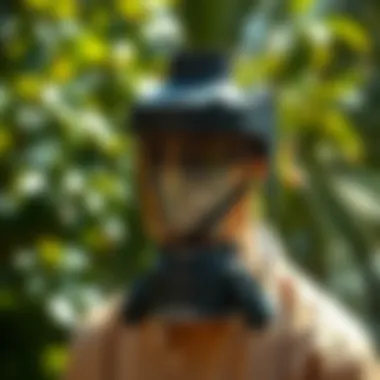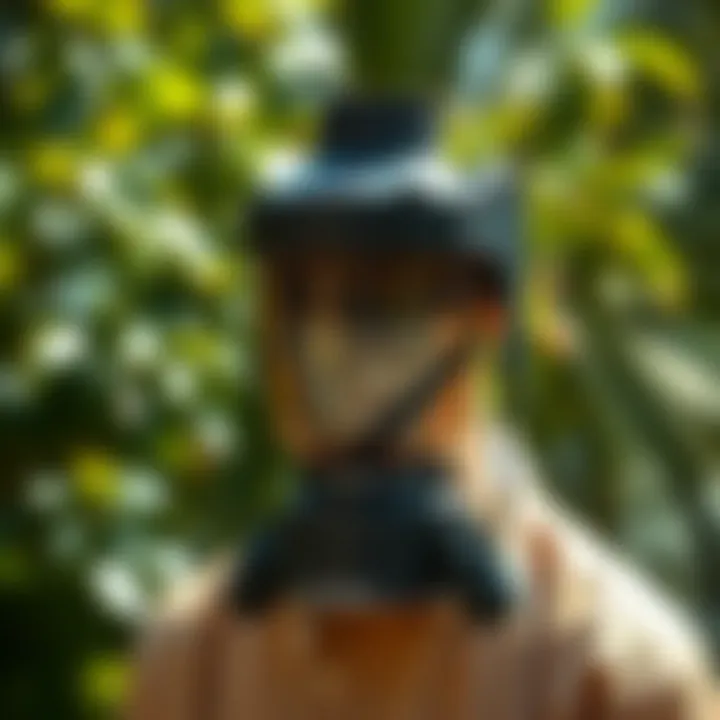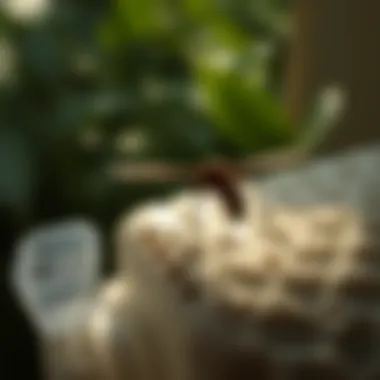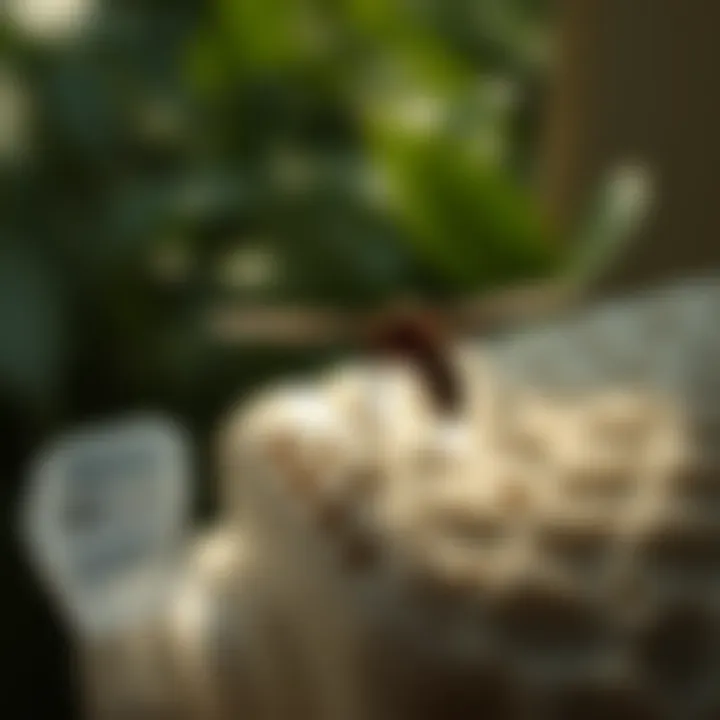In-Depth Review of the Talstar Mosquito Fogger


Intro
Mosquitoes, often viewed as a mere nuisance, pose more than just an inconvenience during outdoor gatherings. They can carry various diseases, making effective pest control essential for homeowners. Amid various solutions on the market, the Talstar mosquito fogger stands out as a practical choice for managing these pesky insects. Understanding how this tool functions can help maintain a more enjoyable outdoor experience. In this article, we will dissect the workings of the Talstar mosquito fogger, assessing its strengths and weaknesses along the way.
Understanding Pests
Definition of Pests
In simple terms, pests are organisms that negatively affect human activities, such as crops, homes, or health. They can take many forms, from insects like mosquitoes and termites to rodents and weeds that intrude on gardens. The distinctive feature of a pest is its ability to multiply rapidly and create significant nuisance or damage.
Importance of Pest Identification
Knowing your enemy is half the battle. Understanding the specific pests invading your domain can lead to more targeted and effective management strategies. For instance, mistaking a mosquito for a harmless fly might result in ineffective solutions. Identifying the type of pest not only streamlines your pest control efforts but also helps in realizing the extent of potential health risks they bring.
Prevention Techniques
Home and Garden Preventative Measures
When it comes to keeping your space pest-free, prevention is often better than cure. Here are several effective strategies to consider:
- Cleanliness: Keeping both indoor and outdoor areas tidy can substantially reduce attractants for mosquitoes. Eliminate standing water, keep food stored properly, and dispose of trash regularly.
- Landscaping Choices: Certain plants can deter pests naturally. Plants like citronella, lavender, and marigolds serve double duty by beautifying your space while also warding off insects.
- Physical Barriers: Installing screens on doors and windows enables airflow without letting unwanted guests inside.
Seasonal Prevention Tips
Each season brings its own set of challenges. Noticing patterns in pest activity can make it easier to prepare. Here are some tips:
- Spring: As temperatures rise, larvae of mosquitoes start to hatch. Scrubbing away any stagnant water pools can hinder their development.
- Summer: Regularly check your backyard for mosquito breeding sites like clogged gutters.
- Fall: This is a time for pesticide application before the cold snaps. Ensure to treat your yard so that pests can’t hibernate over winter.
- Winter: While many pests die off in the cold, you should still check for any remaining nests or burrows.
Eco-Friendly Pest Control Solutions
Overview of Sustainable Practices
In today's world, an increasing number of individuals are leaning toward eco-friendly solutions. They are not only better for the environment but also safer for humans and pets. Here are a few sustainable practices that stand out:
- Integrated Pest Management (IPM): This holistic approach combines various strategies including biological control, habitat manipulation, and some targeted chemical treatments.
- Chemical-Free Options: Utilizing natural insect repellents and insecticides can significantly reduce the negative impacts on beneficial organisms.
Natural Remedies and Their Effectiveness
Many homeowners prefer turning to natural remedies for mosquito control instead of relying on heavy-duty chemicals. Some popular options include:
- Essential Oils: Oils like eucalyptus, lavender, and tea tree oil can repel mosquitoes effectively when diluted and applied.
- Garlic Spray: A simple concoction of garlic and water can act as a natural barrier against various insects.
Prelims to Mosquito Control Techniques
Mosquito control is not just a matter of comfort; it’s a vital component of public health, especially in regions where disease-carrying mosquitoes are prevalent. The rising incidence of illnesses such as West Nile Virus, Zika, and dengue fever serves as a stark reminder of the potential risks associated with mosquito populations. Understanding effective control methods is crucial for homeowners seeking to safeguard their families and neighbors from these pesky flyers and their associated threats.
The Importance of Mosquito Control
Mosquitoes reproduce quickly and can thrive in stagnant water, making it essential to address the issue before it spirals out of control. Effective mosquito control plays a critical role in:
- Protecting Public Health: The transmission of diseases like malaria and chikungunya underscores the need for strategic control methods. This is particularly poignant for households with children or elderly residents who are at greater risk.
- Improving Quality of Life: A yard teeming with mosquitoes is more than just an annoyance; it can severely limit outdoor activity. Effective mosquito management can greatly enhance one’s enjoyment of gardens, patios, and other outdoor spaces.
- Environmental Balance: Strategically managing mosquito populations also supports ecological balance. Employing methods like the Talstar fogger can target problem areas without excessively affecting non-target species.
Overview of Common Mosquito Management Strategies
When tackling mosquito issues, several strategies can be employed, each with its unique advantages and considerations:
- Source Reduction: This basic yet effective tactic involves eliminating standing water where mosquitoes breed. Homeowners should regularly check and empty containers, bird baths, or clogged gutters.
- Biological Control: Introducing natural predators, such as certain fish species, into water bodies can help control mosquito larvae populations effectively. This method maintains an ecological approach without the use of chemicals.
- Chemical Control: For more immediate relief, chemical solutions like foggers can be applied. The Talstar mosquito fogger, for example, disperses pesticides effectively over larger areas, minimizing direct contact while delivering potent results.
- Personal Protection Measures: Beyond systemic strategies, personal warding off is essential. Utilizing repellents containing DEET or wearing appropriate clothing can shield individuals during outdoor activities.
In this analysis, we will explore the Talstar mosquito fogger as one of the prominent tools in chemical control, setting the stage for subsequent sections that delve deeper into its features, operational guidelines, and effectiveness.
Understanding the Talstar Mosquito Fogger
The Talstar mosquito fogger is more than just a piece of equipment; it embodies a strategic response to the persistent challenge of mosquito control in residential and commercial settings. By grasping the nuances of this fogger, users can unlock its full potential, ensuring their efforts against these pests are not only effective but also efficient. Understanding the Talstar fogger includes knowing its specifications, features, and how each contributes to its performance in real-world applications.
Specifications and Features
Diving into the specifications of the Talstar mosquito fogger reveals a sturdy but well-engineered device tailored for several specific uses. This fogger boasts a robust tank capacity, typically around 3 gallons, allowing for extended use without frequent refills, which is crucial when treating large areas. Furthermore, it operates efficiently with a flow rate that can be adjusted, usually between 0.5 to 4 ounces per minute, enabling users to control the concentration of pesticide delivered.
The nozzle design is equally important. It generally incorporates a high-efficiency nozzle that can create a fine mist, allowing for better coverage and penetration into hard-to-reach areas. This is particularly beneficial for areas with dense foliage, where mosquitoes love to hide. Beyond its mechanical attributes, this fogger often features an ergonomic design, making it user-friendly, especially during prolonged applications.


A standout feature of the Talstar fogger is its multi-functionality. Not only does it handle mosquito repellents, but it can also be adapted to use various types of chemical pesticides. This versatile capability makes it a valuable asset in pest control arsenal, catering to a variety of pest challenges that homeowners may face.
Mechanism of Action
At its core, the effectiveness of the Talstar mosquito fogger lies in its mechanism of action. Understanding how it works is crucial for anyone interested in pest control. The fogger operates through a process known as thermal fogging or cold fogging, which vaporizes the pesticide solution and disperses it as a fine mist.
When activated, the motor begins the process of heating or pressurizing the liquid pesticide, breaking it down into incredibly small droplets. This allows the pesticide to spread evenly throughout the air, creating a cloud of protection. The size of the droplets — generally ranging from 10 to 50 microns — optimizes coverage because smaller droplets can drift further, adhering to surfaces and increasing exposure time on the target pests.
In terms of efficacy, the Talstar fogger is designed to impact mosquitoes during their active periods. The active ingredients in the pesticides utilized are typically designed to disrupt the insect's nervous system, effectively immobilizing them in mid-flight.
"Employing the right mosquito fogging technique not only ensures better pest eradication but also enhances safety and efficiency in professional and domestic settings."
In summation, the Talstar mosquito fogger is a well-thought-out design that integrates substantial features and a robust mechanism for targeting mosquitoes, creating an advantageous tool for pest management. Embracing the power of this fogger means not just investing in equipment; it’s about equipping yourself with knowledge to wield its power effectively in the ongoing battle against pests.
Operational Guidelines for Effective Use
Operating a mosquito fogger like the Talstar requires more than just pulling the trigger and hoping for the best. It's about strategy, precision, and being attuned to how the environment interacts with the application. The importance of operational guidelines can't be overstated; they are the backbone of effective mosquito control. Without a solid understanding of proper methods, one could easily waste product, time, and effort while leaving gaps that allow pests to thrive.
Preparation for Fogging
Before you embark on your fogging mission, preparation is key. A successful operation starts long before you even press the button. Consider the following:
- Read the Manual: It sounds basic, but getting acquainted with the Talstar Fogger's manual is a crucial first step. It contains vital information about operation and safety measures.
- Choose the Right Time: Early morning or late evening are optimal forfogging activities. This is when mosquitoes are most active but when wind is typically calm, enhancing the effectiveness of the fogging.
- Clear the Area: Remove pets and people from the vicinity to ensure safety. Make sure to cover anything that shouldn’t get wet, as the fog can linger on outdoor furniture and plants.
- Gather Equipment: In addition to the fogger itself, have extra fuel, pesticides, and protective gear on hand. Having a spare set of gloves or a face mask can save you from a minor inconvenience.
The preparation phase sets the tone for the entire fogging process. Failing to take these necessary steps can easily convert an efficient operation into a chaotic debacle.
Technique and Coverage
Once you are adequately prepared, it’s time to dive into the actual fogging process. Technique matters immensely; just spraying without care will not yield the results you desire. Here are key points to keep in mind:
- Adjust the Nozzle: The Talstar Fogger typically comes with adjustable nozzles. Fine-tune the aperture to ensure you're getting an optimal mist that can travel through the air effectively.
- Walk Slowly: This one's a biggie. Keep a steady, slow pace as you walk through the area. Rapid movements can result in uneven coverage, which leaves some mosquitoes undisturbed.
- Overlap Your Passes: When fogging, ensure that each pass overlaps the previous one by about 30% to avoid any gaps. Think of it as painting a wall; if you miss a spot, the mosquitoes are likely to use that area as a safe haven!
- Check Wind Conditions: Be aware of the wind direction; you want to avoid creating a cloud that drifts back toward your own space. Always apply the fog with the wind at your back.
In sum, effective technique and thorough coverage will maximize your efforts in targeting mosquito populations. Users often find that multiple passes in strategic areas lead to more satisfactory results.
"Preparation and proper technique yield results; neglecting them can waste time, product, and money."
Follow these operational guidelines for the Talstar fogger, and you'll likely find your mosquito control efforts yielding far better outcomes than if you had flown by the seat of your pants.
Safety Precautions with Talstar Foggers
When it comes to using the Talstar mosquito fogger, prioritizing safety cannot be overstated. Effective pest control should not come at the cost of health or environmental integrity. This section delves into essential safety precautions, focusing on protective gear and environmental considerations, creating a safer experience for both the operator and the surrounding community.
Protective Gear Recommendations
Using a fogger like the Talstar effectively requires the right protective gear. The fogging solution, while effective against pesky mosquitoes, carries potential risks to human health and the environment. Here are key recommendations for protective gear:
- Respirators: A high-quality respirator is crucial. Look for one with a P100 filter to mitigate inhalation risks from chemical fumes.
- Gloves: Nitrile gloves provide a good barrier against chemicals, ensuring that no harmful substances come into contact with the skin.
- Eyewear Protection: Safety goggles should be worn to protect the eyes from accidental splashes.
- Long Sleeves and Pants: Wearing long-sleeved shirts and long pants acts as an additional barrier against any accidental chemical exposure. Opt for light-colored clothing, which can help in detecting any spills.
By donning this protective gear, operators can minimize personal risk while conducting fogging activities.
Environmental Considerations
A critical aspect of using the Talstar fogger is understanding its environmental implications. While designed to control mosquito populations efficiently, it’s essential to analyze how its use can affect non-target species and the ecosystem as a whole.
- Pollinators: Bees and other beneficial insects may be adversely affected by the chemicals used. Fogging should ideally be done in the evening when pollinators are less active.
- Water Sources: It is vital to prevent pesticide runoff into nearby water bodies, as this can have devastating effects on aquatic life. Fogging should be conducted with attention to water flow and areas of potential runoff.
- Sensitive Areas: Identify and avoid fogging in habitats for wildlife. For instance, if your garden is a haven for birds or butterflies, consider alternatives or localized application techniques.
"Environmental protection is not just about preserving nature; it is about ensuring that our health and future are secure."
Efficacy and Performance Evaluation
Evaluating the efficacy and performance of any pest control solution, including the Talstar mosquito fogger, is essential for making informed decisions about mosquito management. A fogger’s effectiveness essentially determines how well it performs its job—keeping those pesky mosquitoes at bay. Understanding its actual impact on insect populations, alongside how long its effects last, will guide homeowners and caretakers in selecting the best strategy for their unique situations.
Effectiveness Against Target Pests
The Talstar mosquito fogger is designed to target a variety of pest species, primarily mosquitoes. Its effectiveness can vary based on several factors:
- Active Ingredients: Talstar contains Bifenthrin, which is known for its potency against mosquitoes and ticks. Users often report significant reductions in mosquito activity after application.
- Application Timing: Timing is crucial. For best results, using the fogger during dawn or dusk when mosquitoes are most active improves effectiveness.
- Environmental Conditions: Weather plays a key role; windy or rainy conditions can disperse the fog too quickly, reducing its impact. Ideally, fogging should occur in calm, dry weather for the best results.
Actual user experiences indicate that a single application can dramatically diminish mosquito presence in residential areas, often providing relief for several days. Effectiveness assessments generally confirm that Talstar provides a high knockdown rate, which is particularly beneficial in areas with heavy mosquito populations.


Duration of Effectiveness
Another significant aspect of the Talstar mosquito fogger is how long its effects last. Effectiveness is not just about immediate results; it’s also about how long those results hold:
- Residual Activity: Talstar has a residual effect that can last up to 30 days under optimal conditions. This means that while there's an immediate reduction in mosquito numbers, protection continues for several weeks.
- Reapplication Scheduling: To maintain an effective barrier against pests, reapplication is advised every 2-4 weeks. Many users follow a seasonal schedule based on mosquito breeding cycles to maximize its effectiveness.
- Consideration of Habitat: Areas with dense foliage or water bodies may require more frequent application, as these environments can sustain mosquito breeding.
The success of mosquito management often hinges on both the quality of the product used and the adherence to recommended practices, from timing to reapplication.
Combining an understanding of effectiveness and longevity facilitates optimized pest control. Homeowners wielding this knowledge can tailor their strategies for the best results. Evaluating the Talstar fogger through these lenses ensures that families can enjoy their outdoor spaces without the constant annoyance of mosquitoes.
Comparative Analysis with Other Fogging Solutions
The process of mosquito control has seen various techniques over the years, but among the hyped approaches, fogging with Talstar stands out. Comparing it with other fogging solutions can bring to light the unique advantages it offers, as well as considerations potential users should be aware of. When looking at different fogging methods, it becomes evident that understanding their nuances can play a pivotal role in making informed choices.
Talstar vs. Thermal Foggers
Thermal foggers operate by heating a liquid pesticide until it vaporizes into small aerosol droplets. This technique allows for rapid application and efficient coverage, especially in larger outdoor areas. However, the effectiveness hinges on temperature and humidity levels. In contrast, Talstar foggers deliver a more consistent application regardless of such environmental variables. The droplets produced by the Talstar system are more uniform in size, leading to better coverage on surfaces that mosquitoes are likely to land on.
One significant difference lies in the types of chemicals used. While thermal foggers often rely on oils which can lead to increased residue on surfaces, Talstar utilizes a water-based solution that minimizes residue buildup. This can be an important factor for homeowners who wish to maintain a clean aesthetic in their outdoor spaces.
"In the battle against mosquitoes, choosing the right equipment can mean the difference between effective control and an uphill struggle."
Talstar vs. Other Chemical Solutions
When Talstar is compared to other chemical solutions employed in fogging, the range of active ingredients comes into play. Many alternatives utilize pyrethroid compounds, which might seem similar to those found in Talstar. However, the specific formulation within Talstar provides a longer residual effect on surfaces, making it effective against even the most resilient mosquito species.
Moreover, certain chemical solutions may come with increased smells or potential irritations that can deter homeowners from consistent use. In contrast, Talstar’s formulation typically features reduced odors, ensuring that the application process is as non-disruptive as possible for families and pet owners alike. Moreover, the safety data sheets usually indicate a lower toxicity level compared to others, resulting in greater peace of mind for the user's household and pets.
In summary, whether it's thermal foggers or other chemical sprays, evaluating Talstar requires looking beyond mere ingredients; one must consider the overall experience and outcomes of usage. Each fogging solution has its own strengths and weaknesses, making a comparative analysis essential for those aiming for effective mosquito management.
Case Studies and User Experiences
Understanding the real-world applications of the Talstar mosquito fogger offers valuable insights into its effectiveness and suitability for different settings. Case studies provide concrete evidence of how users have benefited from the fogger, highlighting both successes and challenges faced during its use. This scrutiny not only aids prospective users in grasping the potential advantages but also addresses any possible reservations they may have regarding the device.
Residential Applications
In residential settings, the Talstar mosquito fogger has garnered attention for significantly reducing mosquito populations. Homeowners have reported varying degrees of success, depending on factors such as location, mosquito species, and local environmental conditions. For instance, a homeowner in the humid regions of Florida noted a dramatic drop in the mosquito presence around their backyard after using the fogger consistently over several weeks. They stated that evening barbecues became more enjoyable without the incessant buzzing and biting of mosquitoes.
Some users recommend a two-pronged approach: utilizing the fogger alongside natural repellents. This combination leads to a fuller spectrum of pest control. These accounts emphasize the benefit of a targeted spray application, noting that fogging during peak activity hours can yield the best results.
Moreover, case studies have shown that proper maintenance and calibration of the fogger play a key role in its effectiveness. One user shared how adjusting the nozzle and ensuring the right mix of Talstar in the fogger made all the difference in their pest control outcomes. Reports such as this underscore the necessity for straightforward operational guidelines to help users maximize their mosquito control efforts.
Commercial Use in Public Spaces
The application of the Talstar fogger in commercial spaces presents a different set of challenges and successes. Businesses, especially those in hospitality and outdoor recreation, have turned to the fogger as an essential tool in maintaining guest comfort. Case studies from resorts highlight successful integration of fogging practices before events or peak visitor seasons.
One such resort in Texas reported using the Talstar fogger to prepare their outdoor dining area for a busy summer season. The management noted that proactive measures led to enhanced guest satisfaction and a reported decrease in complaints regarding mosquito encounters. This illustrates how timely applications can enhance the overall experience for visitors.
However, it’s essential to address the balance between pest control and public health. Some businesses have faced scrutiny from environmental groups, which raises ethical questions about chemical use in public amenities. Case studies reflect a growing trend where companies prioritize transparency, sharing their pest control measures with customers to build trust.
In summary, the experiences drawn from residential and commercial applications of the Talstar mosquito fogger not only provide testament to its effectiveness but also flag critical areas of consideration, including environmental impact and user engagement. By examining these real-life scenarios, users can glean practical insights that shape their own pest management strategies, creating a safer and more enjoyable environment.
Addressing Environmental Impact
The conversation surrounding pest control techniques, particularly mosquito management, often brushes over crucial environmental considerations. This section aims to emphasize how effective practices can align with ecological responsibility when using tools like the Talstar mosquito fogger. In this realm, we must ask ourselves: how do our pest control methods affect the broader ecosystem? Understanding this context is vital, as it shapes not only our approach but also our legacy in maintaining a harmonious home and garden environment.
Impact on Non-Target Species
When employing any form of pest control, including the application of the Talstar fogger, we must be cognizant of non-target species—those organisms that are not the intended victims of our efforts. While Talstar is primarily designed to vanquish mosquito populations, there exists a real risk of collateral damage to beneficial insects like bees, butterflies, and even certain bird species. These creatures, pivotal in pollination and sustaining local biodiversity, may be inadvertently affected by residual chemical exposure.
To mitigate these risks, operators are encouraged to:
- Time Applications Wisely: Fogging should be conducted early in the morning or late in the evening when the activity of non-target species is diminished.
- Target Specific Areas: Focus on areas where mosquitoes breed or gather, avoiding flowers and flowering plants to protect pollinators.
- Follow Application Guidelines: Always adhere to label instructions and safety data, which outline best practices regarding application rates and schedules.
This method can help ensure that our efforts to control mosquito populations do not come at an unreasonable cost to our environment.
Long-term Ecological Effects
It's crucial to consider the long-term implications of using chemical solutions like the Talstar mosquito fogger on the environment. While immediate results may be attractive—reducing mosquito annoyances and associated diseases—the environmental impact can echo through time. Pesticides can accumulate in soil and water systems, affecting not just immediate areas but broader ecological networks.


Research suggests that over time, the long-term presence of these compounds can alter microbial communities in the soil, which play a significant role in nutrient cycling and plant health. Additionally, persistent chemical residues may contaminate water systems, potentially impacting aquatic life and drinking water quality.
To combat these issues, residents must:
- Conduct Regular Monitoring: Assess the health of local ecosystems following fogging events, taking note of observable changes in flora and fauna.
- Engage in Integrated Pest Management (IPM): Explore holistic approaches that combine biological, cultural, and mechanical strategies with chemical methods, minimizing reliance on fogging alone.
- Educate and Advocate: Stay informed and engage with local environmental initiatives that promote sustainable pest control practices, ensuring that our approach to mosquito eradication aligns with the overall health of the environment.
Adopting these strategies will foster a balance between effective mosquito control and ecological well-being, ensuring a healthier environment for generations to come. By keeping the worries about non-target species and potential long-term ecological effects in our minds, we can strive for effective, responsible pest management practices.
"The care for our environmental responsibilities today will safeguard the sustainability of our ecosystems tomorrow."
For more on sustainable pest management practices, consider visiting Wikipedia's Pesticide page or EPA's guidelines.
Consumer Considerations and Cost Analysis
When it comes to dealing with mosquito invasions, many homeowners find themselves grappling with a multitude of factors. The Talstar mosquito fogger often comes up as a viable choice in the pest control toolbox. Understanding the financial and practical implications of using this fogger can be pivotal for homeowners and housewives alike. Key elements include the initial investment, ongoing costs, and overall effectiveness in providing relief from pesky mosquitoes.
Cost-Effectiveness of the Talstar Fogger
Analyzing the cost-effectiveness of the Talstar mosquito fogger delves deeper than merely looking at its price tag. The initial plunge into purchasing the product often makes or breaks a homeowner’s decision. The Talstar fogger is reasonably priced when compared to commercial pest control services, which can be a heavy hit on your wallet over time.
Here are a few points to consider regarding cost-effectiveness:
- Initial Investment: The Talstar fogger might require a bigger upfront investment than budget options. However, many find that the long-term savings on pest control services justify this expense.
- Operating Costs: Unlike ongoing pest control services where fees recur, the Talstar fogger primarily incurs costs for its chemicals. Talstar's formulation is efficient, meaning you tend to use less chemical per treatment compared to alternatives, subsequently reducing total expenses.
- Effectiveness: Most importantly, consider the results. If your yard transforms into a mosquito-free zone after using the fogger, the cost becomes a mere footnote instead of a headline.
Availability and Purchasing Options
Finding a Talstar mosquito fogger doesn’t have to be a headache. Familiarizing yourself with the options of purchasing the fogger can save time and effort. You’ll want to scout both physical and online outlets to see where the best deals lie.
- Brick-and-Mortar Stores: Many home improvement stores, like Home Depot or Lowe’s, will carry the Talstar fogger on their shelves. You can physically check the product, which is a comfort for some.
- Online Platforms: Retailers such as Amazon often have competitive pricing and the added benefit of convenient home delivery. Before you make a choice, check customer reviews for real-world performance insights.
- Local Distributors: Local agricultural suppliers may also stock the fogger, potentially offering bulk discounts or seasonal promotions. This is worth looking into, especially for larger properties or those who want to use the fogger frequently.
In summary, understanding consumer considerations around the Talstar mosquito fogger pieces together a clearer view for the homeowner. The cost-effectiveness and the variety of purchasing options are pivotal in deciding if this tool meets your mosquito management needs. Gathering this intel empowers buyers to make choices that suit both their budgets and living spaces.
"A dollar saved is a dollar earned," as the old saying goes. With the right information, your mosquito control can become more than just a chore—it can become a smart investment.
Regulatory Guidelines and Compliance
Understanding regulatory guidelines is essential for anyone using the Talstar mosquito fogger. Not only do these regulations ensure safe application, but they also protect health and the environment. As users, especially homeowners, it's crucial to be aware of the legal landscape surrounding pesticide use.
Understanding Pesticide Regulations
In the realm of pest control, pesticide regulations serve as a framework governing the production, distribution, and application of these substances. Here's why they matter:
- Health & Safety: Regulations help in minimizing risks to human health. They dictate how and when pesticides can be applied, emphasizing methods that reduce exposure.
- Environmental Protection: Proper adherence to regulations aids in safeguarding ecosystems. Guidelines restrict chemical runoff into waterways and protect non-target species from unintentional harm.
- Legal Compliance: Ignoring laws can bring hefty fines and penalties. It's as simple as that—knowing the rules keeps you both compliant and safe from legal issues.
Moving deeper, let’s consider some of the key elements of these regulations. They often vary from one region to another, so checking local guidelines is imperative. This often means consulting state or local agricultural extensions, like e.g., extension.uaf.edu or e.g., www.epa.gov.
Certification Requirements for Operators
Certifications serve as a badge of trust in the world of pest management. For those using the Talstar mosquito fogger—either professionally or as a serious hobbyist—there may be specific qualifications required. Here are a few considerations:
- Operator Training: Many regions require operatives to undergo formal training. This often includes learning about safe handling, application techniques, and understanding product intricacies.
- License: Depending on the region, obtaining a pesticide applicator license may be necessary. This license ensures that the operator has met certain educational standards and understands the potential risks involved in pesticide application.
- Record Keeping: Operators may also be required to maintain records of pesticide use, including details such as the date, location, and type of pest targeted. This documentation proves essential not just for compliance, but also for assessing the long-term effectiveness and safety of the treatments used.
"Pesticide regulations are not merely rules; they are the roadmap to responsible pest management that emphasizes both efficacy and sustainability."
Overall, navigating the regulatory landscape is vital for anyone serious about using the Talstar mosquito fogger. It ensures not only legal compliance but also safeguards health, safety, and the environment for everyone involved.
Culmination and Recommendations
As we draw this discussion to a close, it becomes clear that an effective mosquito management strategy is crucial for both comfort and public health. The Talstar mosquito fogger stands out as a potent tool in this battle against these pesky pests. The comprehensive understanding gained through this article underscores the need for informed choices when selecting mosquito control methods.
Final Thoughts on Mosquito Control
During warmer months, mosquitoes can be more than just an annoyance; they are carriers of diseases such as West Nile virus and Zika virus. Prioritizing mosquito control is essential to ensure a safe and enjoyable outdoor environment. Although Talstar offers a promising solution, recognizing that it is only one of many strategies is important. Using multiple methods—like eliminating stagnant water and using repellents—can enhance overall effectiveness. Integrated pest management means understanding the unique dynamics of your environment and tailoring your approach accordingly. For housewives and homeowners, maintaining a clean yard and working on community efforts can also play a significant role in controlling mosquito populations. The more informed the community, the better the outcome in reducing mosquito presence.
Best Practices for Implementation
When it comes to applying the Talstar mosquito fogger effectively, a few best practices can optimize your effort:
- Read the Manual Thoroughly: Before using the fogger, ensure you are fully aware of its operation, as each model may differ slightly.
- Choose the Right Time: Early morning or late evening is often the best time to fog, as mosquitoes are most active then.
- Use in Calm Weather: Wind can disperse the chemical too widely, reducing its effectiveness. Tranquil conditions allow for better coverage.
- Target Breeding Areas: Pay special attention to areas where mosquitoes breed or rest, like tall grass or dense vegetation.
- Maintain Equipment: Regular cleaning and maintenance of your fogger will ensure it works optimally over time.
Using these practices provide a strategic edge, enhancing the effectiveness of mosquito control efforts. Adhering to safety precautions, such as wearing protective gear, further contributes to safe and effective fogging sessions.
By understanding the dynamics of mosquito populations and utilizing tools like the Talstar mosquito fogger correctly, homeowners can manage pests more effectively and improve their outdoor quality of life.
Implementing these recommendations and insights will position homeowners as informed agents in the fight against mosquitoes, leading to healthier living environments.



